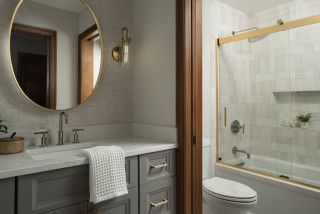
This article was originally published by a www.houzz.com . Read the Original article here. .

This article was originally published by a www.houzz.com . Read the Original article here. .

The Federal Housing Administration backs several home renovation loan options offered through private lenders.
If your renovation goal is to make your home more livable, useful, accessible or energy-efficient, you might qualify for a Title 1 fixed-rate loan. The maximum loan amount for a single-family home is $25,000, and amounts less than $7,500 are usually unsecured. The payout is a lump sum, and the interest rate is fixed.
If you need to borrow more than $25,000, you might qualify for a 203(k) loan (for major work). This combines a renovation loan with a mortgage. A portion of the loan goes toward purchasing the home, and the rest is paid to the contractor as needed. The interest rate can be fixed or variable.
This article was originally published by a www.houzz.com . Read the Original article here. .

The Federal Housing Administration backs several home renovation loan options offered through private lenders.
If your renovation goal is to make your home more livable, useful, accessible or energy-efficient, you might qualify for a Title 1 fixed-rate loan. The maximum loan amount for a single-family home is $25,000, and amounts less than $7,500 are usually unsecured. The payout is a lump sum, and the interest rate is fixed.
If you need to borrow more than $25,000, you might qualify for a 203(k) loan (for major work). This combines a renovation loan with a mortgage. A portion of the loan goes toward purchasing the home, and the rest is paid to the contractor as needed. The interest rate can be fixed or variable.
This article was originally published by a www.houzz.com . Read the Original article here. .
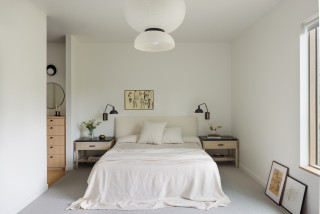
Replacing bland window treatments with elegant draperies or shades makes any room look finished. But the right window treatments can do much more, including dampen sound, provide insulation, block light and enhance privacy — all critical in a bedroom. If yours are failing in any of these regards, think of an upgrade as an investment in your well-being.
Sheer curtains can be layered over a roller or cellular shade for privacy and light control. Thick or lined draperies don’t necessarily need to be layered, but if you go without, swap your straight rod and finials for a French return curtain rod, which bends all the way to the wall, to block more light. Similarly, if choosing Roman shades, you’ll have less light leakage if you select an outside mount shade than an inside-mount design.
That said, while we need darkness to fall (and stay) asleep, the morning sun is helpful for waking us up. Blackout shades can disrupt that natural cue. If you need them, one solution is to install smart shades that are raised automatically at a designated time in the morning.
Which Window Treatment Should You Choose?
What to Know About Curtains and Drapes
This article was originally published by a www.houzz.com . Read the Original article here. .
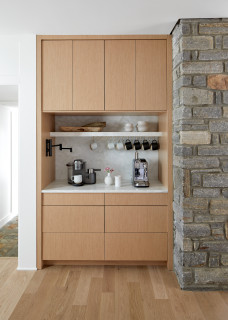
Forgo the everyday tableware and pull out things you save for special occasions. This means a favorite tablecloth or runner, Grandmother’s plates or rarely used crystal glasses. Bring out the cloth napkins and candles.
This shouldn’t feel like a chore, but rather a time to appreciate the finer things you have at home. Treat it like a creative project and have family members take turns so they can play with color, mix and match china and experiment with centerpieces. If you have kids, have them make place cards. It will make meals feel like an event.
This article was originally published by a www.houzz.com . Read the Original article here. .

“We are frequently considering how things will work in 20 years’ time and all that’s in between,” says designer Steve Root of Roots Kitchens, Bedrooms and Bathrooms. “That means thinking about how the homeowners’ needs might change, how lifestyles may develop, how things will wear and break and, thus, how they can be maintained.”
But that doesn’t means a kitchen without character. Because when form and function work hand in hand, you’re winning at design.
This article was originally published by a www.houzz.com . Read the Original article here. .

“We are frequently considering how things will work in 20 years’ time and all that’s in between,” says designer Steve Root of Roots Kitchens, Bedrooms and Bathrooms. “That means thinking about how the homeowners’ needs might change, how lifestyles may develop, how things will wear and break and, thus, how they can be maintained.”
But that doesn’t means a kitchen without character. Because when form and function work hand in hand, you’re winning at design.
This article was originally published by a www.houzz.com . Read the Original article here. .
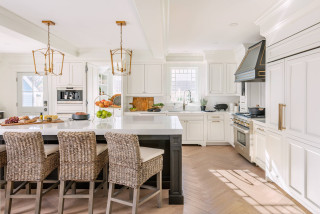
Fortunately, these days you’ve got digital tools available that allow you to stay on top of projects, even when you’re sunning yourself on a beach. Combine these with some effective client and team communication before you step away and you’ll set yourself up for a stress-free break. Here’s how to go about it.
This article was originally published by a www.houzz.com . Read the Original article here. .

This Victorian-era English kitchen was in need of a revamp, but the owner wanted to stick with white for the walls and countertop.
“She was quite nervous about using color,” says designer Natasha Burton of NB Interiors UK. Burton suggested gently adding interest through the use of soft pink lower cabinets, subtle pattern on the floor and a few key brass details.
In addition to bringing warmth to the small room, brass also has cleverly been used to tie the design into the era of the house. The brass door plates shown here, for example, are a nod to the Ingatestone, Essex, home’s Victorian heritage, as well as a practical addition to the narrow swing doors.
Find a kitchen designer near you
This article was originally published by a www.houzz.com . Read the Original article here. .
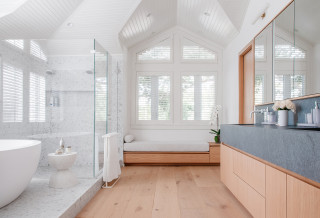
Lighting is often called the jewelry of a room, but given its functional importance, especially in a bathroom, that analogy might be selling it a bit short.
One easy way to improve the functionality, safety and look of a bathroom through lighting is to add hidden LED strips. They can be placed under toe kicks, shelves and cabinets, boosting ambient light during the day and providing soft illumination at night. Waterproof versions can illuminate your shower niche or threshold, improving visibility. The strips can be hardwired by an electrician, but they’re also available in plug-in and rechargeable versions.
Some light fixtures are designed to be virtually invisible. The rest, including your vanity sconces, should work hard and also look great. The easiest approach is to keep your new sconces in the same locations as the old ones, but if your vanity sconces are overhead, you may want to hire an electrician to move them to either side of your mirror. This will provide more even lighting and an up-to-date look.
Tip: Be sure to check whether fixtures are damp- or wet-rated and to adhere to local code when replacing or moving fixtures.
Your Guide to Perfect Bathroom Vanity Lighting
Tell us: What small updates made a big difference in your bathroom? Share in the Comments.
More on Houzz
Read more stories about bathroom design
Find a bathroom remodeler
Shop for bathroom products
This article was originally published by a www.houzz.com . Read the Original article here. .
Unless you’re planning a wet room, you don’t need to cover every inch with tile, Ghaly says. Not only is tiling just part of the room cheaper, both in terms of labor and materials, but also it’s often more practical.
“The advantage of part-tiling is that the bathroom becomes much more flexible,” he says. “For example, you can paint the rest of the walls, which means the bathroom can be redesigned more easily in the future, using different colors.
“Hanging pictures on bathroom walls is also becoming popular, and part-tiling gives you this option,” he adds.
When it comes to tile prices, Ghaly says, ceramic tiles are generally cheaper. “Imitation tiles — marble-look, for example — can be inexpensive yet will give your bathroom a similar luxury look and feel like the real thing.”
Shop for bathroom tile on Houzz